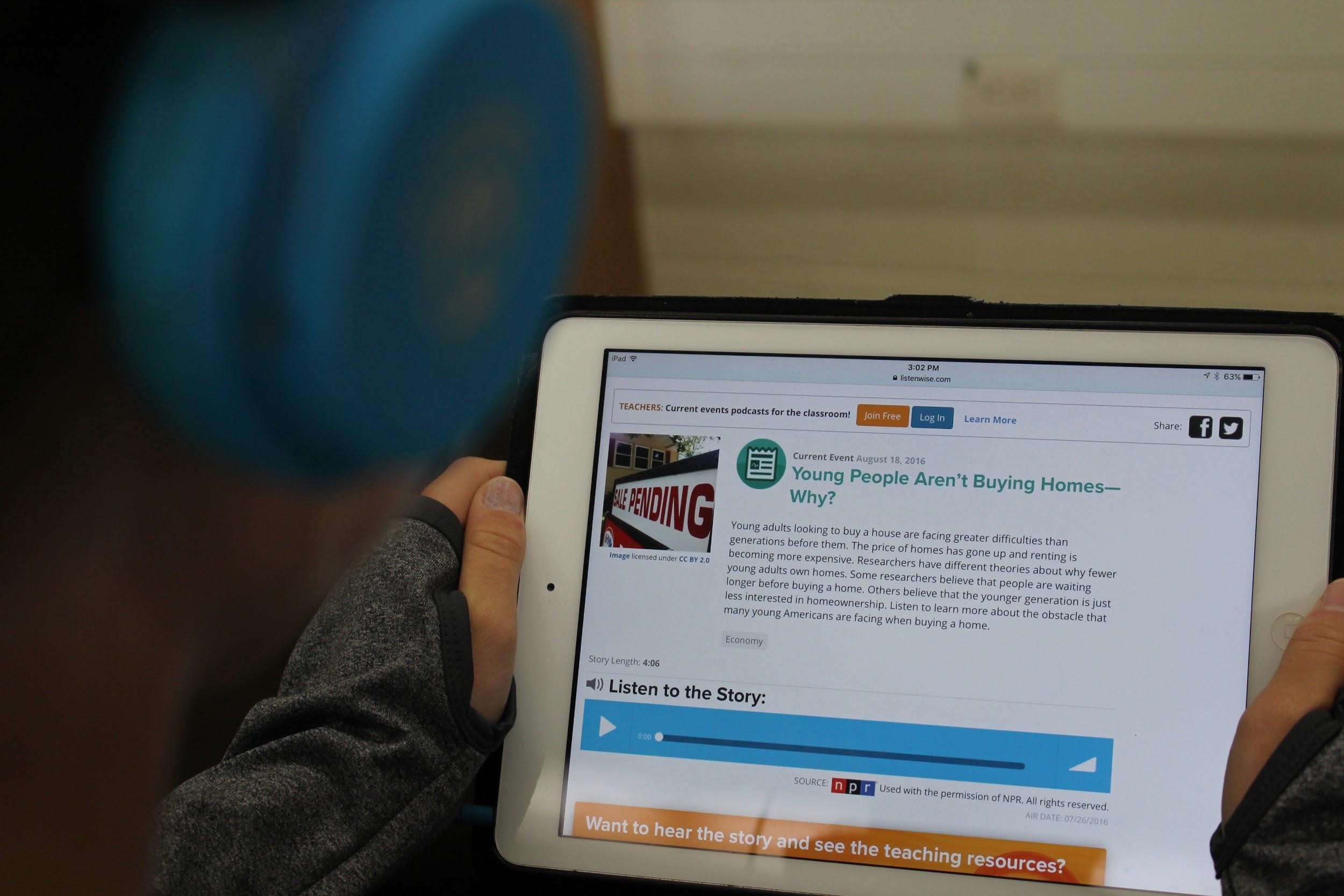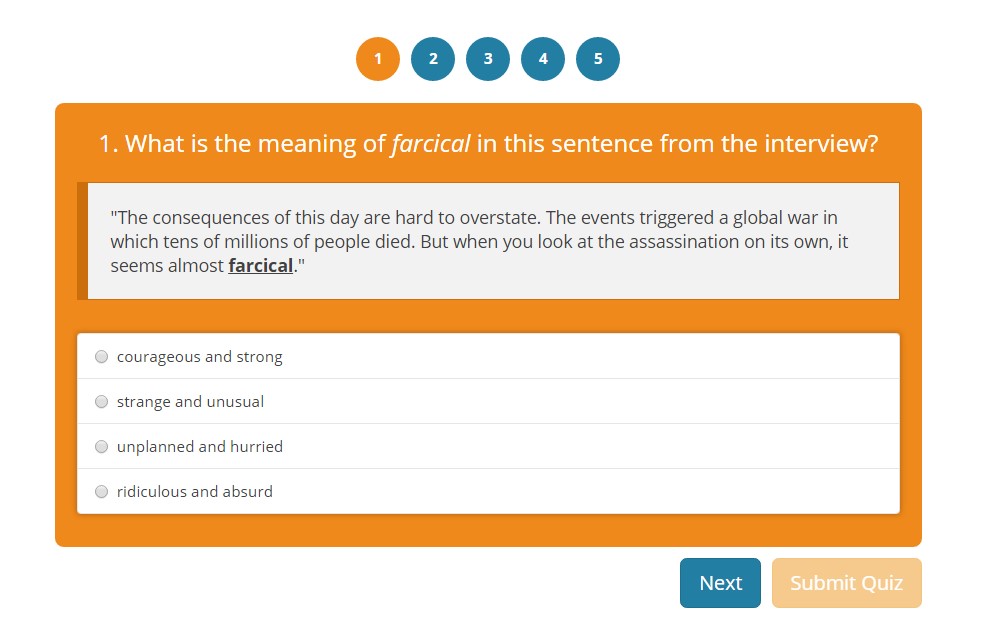Teaching and Assessing ELLs' Listening Skills with Listenwise
 Listenwise is a website that offers teachers free access to curated public radio stories and podcasts along with supporting materials that have a special emphasis on current events as well as other content areas. Listenwise also includes resources that are particularly helpful for ELLs, such as interactive transcripts, tiered vocabulary lists, graphic organizers for active listening, and reduced speed audio. (Learn more about these resources as part of Listenwise's Premium features for schools.)
Listenwise is a website that offers teachers free access to curated public radio stories and podcasts along with supporting materials that have a special emphasis on current events as well as other content areas. Listenwise also includes resources that are particularly helpful for ELLs, such as interactive transcripts, tiered vocabulary lists, graphic organizers for active listening, and reduced speed audio. (Learn more about these resources as part of Listenwise's Premium features for schools.)
In this article written for Colorín Colorado, Listenwise's founder, former public radio journalist Monica Brady-Myerov, shares what she has learned about teaching and assessing listening for students, particularly ELLs.
A Question That Changed My Life
For many years, I reported on education as a public radio journalist. My career was in audio storytelling, and I had experience covering politics and religion as well. But I was also a mother with two young kids. And it was one morning at breakfast when I was listening to NPR with my children as we still do every morning that my daughter asked a question that changed my life — and I hope the lives of many students.
"What is waterboarding?" she asked. She was in the 3rd grade at the time, only 7 years old. I didn't think she was listening to the story about the CIA torture method, let alone understanding it and having questions. I wrongly assumed she was tuning it out. But she was absorbing it at a higher level than I could have imagined. If I had given her the transcript of the story to read, there was no way she could have understood it. But she listened and understood. That was the moment I realized that there's a wealth of amazing content on public radio that just needs to be unlocked for middle and high schools students, and it was the moment that Listenwise was born.
Listenwise in the Classroom
Helping ELLs Improve Their Listening Skills
As we built Listenwise into a library of public radio stories around ELA, social studies, and science curriculum themes, we were developing a resource that gave teachers an engaging way to teach topics such as the start of World War II, Black History, or Women's History through audio stories. But we were also building something bigger: a tool that helps teachers focus on and improve the skill of listening. I soon learned there was a real desire on the part of teachers to help kids improve their listening skills, but they had very few resources available to help them in that effort. For example, if you Google "listening skills", you get about 7 million responses, and most of them are about building better listening skills within your sales team or among business executives. But there's very little about students improving their skills — especially for English language learners (ELLs) who want to improve their language skills through listening.
For ELLs wh o are at an intermediate level and above (for example, WIDA level 3 or higher), these public radio stories are a great way to expose them to conversational English and advanced vocabulary. Listening is a great equalizer, allowing ELLs to access the same content as native speakers while they are improving their language abilities. Students' receptive vocabularies can be at least two grade levels higher than their expressive vocabularies. So when students listen to stories with more difficult vocabulary, they stretch their receptive abilities. This also helps them develop a personal context for the vocabulary and retain the meanings.
o are at an intermediate level and above (for example, WIDA level 3 or higher), these public radio stories are a great way to expose them to conversational English and advanced vocabulary. Listening is a great equalizer, allowing ELLs to access the same content as native speakers while they are improving their language abilities. Students' receptive vocabularies can be at least two grade levels higher than their expressive vocabularies. So when students listen to stories with more difficult vocabulary, they stretch their receptive abilities. This also helps them develop a personal context for the vocabulary and retain the meanings.
In many schools, teaching listening as an important skill falls away after students learn to read, but we have seen more schools starting to pay attention to this core language development skill. The Common Core has recently given Speaking and Listening more attention as an Anchor Standard and focuses on these skills on the SBAC tests in many states. Yet there have been no K-12 tools devoted to building listening skills...until now!
Tracking and Testing Listening Skills
To improve a skill, you must first be able to test and track it. And I quickly found that, just as there weren't many resources to teach listening skills, there was no online listening measure that could track key listening skills as identified by research.
We began research to create formative assessments to integrate into our curriculum collections for easy integration into instruction without additional testing time. Our curriculum team established a listening skills matrix to identify the eight key elements of listening that we wanted to assess and how they align to the Common Core State Standards:
- Literal
- Main Idea
- Vocabulary
- Speaker’s Purpose and Point of View
- Summarizing
- Inferencing
- Analyzing Speaker's Reasoning
- Finding Evidence
These elements are seen in reading assessments and are useful skills to master when listening as well. For example, when students are able to hear a speaker's voice, they can pay attention to the tone, emphasis, and pacing of the speech to make inferences and identify the speaker's point of view. The kinds of natural speech found in these stories is not organized as a well-written essay, with a topic sentence or linear progression of ideas, so students need to practice identifying and summarizing the most important ideas in the audio.
Creating Listening Quizzes
Once the important elements of listening were identified, we were ready to start writing listening quizzes based on our library of public radio stories, but we faced a challenge. It was difficult to find test writers with experience writing questions to assess listening. The closest we could find was people who wrote test questions for reading tests. So we hired experienced reading item writers.
To review the questions, our team and some students took the quiz. We found that on most of the key elements of testing listening, their questions and our answers lined up. But in the questions about the main point of the story, there was always something a little off. The main point question posed by the test writers wasn't wrong, exactly, but it wasn't always what I or our editor thought was the main point of the story. Why was that?
I asked our item writers to walk me through the process of how they created the quiz. They received the assignment, they were given the audio file and the transcript, and they started writing, referring continually to the transcript.
"At what point in this process do they listen to the story?" I asked.
The answer: they weren't listening to the story. They were reading the transcript and basing the questions on the text, as you would a reading test.
Yet they weren't writing reading tests — they were writing listening tests! And uncovering this flaw in the process highlights the very reason why a listening test is so important. Once the quiz writers started listening to the audio, the questions they wrote were more connected to the experience of listening to the story — feeling the emotions and putting themselves in the experiences heard in the story, and not only the facts and details.
When you hear a radio story where people speak in their own words, you come away with something different from if you read the same story. Researchers who study how audio affects attention and memory believe that listening requires more from your brain. The brain sees what it hears — this is what we call auditory scene analysis. Every time a person hears something the brain visually simulates what it hears. A number of researchers call this concept "immersed experience view." Your brain is making a movie, including the sights and smells of what it's hearing.
 Listening is the pathway to empathy. Good stories told aloud allow the listener to connect emotionally to the people speaking — make them feel something. This makes listening an extremely visual medium with great potential for use in teaching and learning. It helps students put themselves in someone else's shoes and really feel that experience.
Listening is the pathway to empathy. Good stories told aloud allow the listener to connect emotionally to the people speaking — make them feel something. This makes listening an extremely visual medium with great potential for use in teaching and learning. It helps students put themselves in someone else's shoes and really feel that experience.
Take our listening challenge!
Try out listening to one of these fascinating stories, feel the immersive experience for yourself and see how your listening comprehension skills line up with our listening challenge.
How Teachers Are Using Listenwise
Teachers are using these Listenwise quizzes to gather data on student listening skills, and there are also a number of teachers using quizzes with English language learners. The preliminary results are the same — students' listening skills can improve with our quiz. Teachers are seeing that students gain vocabulary through context after multiple listens, and are particularly interested in stories that are culturally relevant. One EL teacher said, "I teach students from many different countries. These stories often describe similar situations to those my students have lived through, which allows them to own their learning."
Another EL teacher in MA, Julia Zemetres, found that her students liked using the slower audio when they took the quizzes. Most of her students would listen twice before answering the comprehension questions. "Listenwise has prompted me to adapt my teaching. With the Listenwise Class Summary Report, I can see that my ELLs' inferencing, summarizing, and analyzing skills are consistently weak. Therefore, I will incorporate lessons where students can continue to implement these valuable skills to what they read and hear."
We hope teachers use these quizzes to encourage students to understand that listening is a discrete skill that should be practiced and can be improved. And for students learning to speak English they can challenge themselves to hear many different voices in a fun engaging way. We've found that public radio really works well for students learning English. It's natural, authentic language, the topics are current and engaging, and students get to hear diverse voices of different ages, accents, and dialects.
The pairing of content and language teaching is critical for English learners to develop the academic skills and academic vocabulary necessary to improve their language and be successful in meeting standards. We are so glad that Listenwise is now part of the toolkit that teachers have at their disposal to help their students continue their successful language development.
Sign up for Listenwise
Learn more about how teachers are using Listenwise and sign up for a free Listenwise account on the website, which gives you access to podcasts and current events features. You can also learn about Premium features for schools, such as interactive transcripts, listening quizzes, assessment reporting by listening skills, standards-aligned lessons, differentiated assignments, reduced speed audio, tiered vocabulary, and progress monitoring.







Add new comment